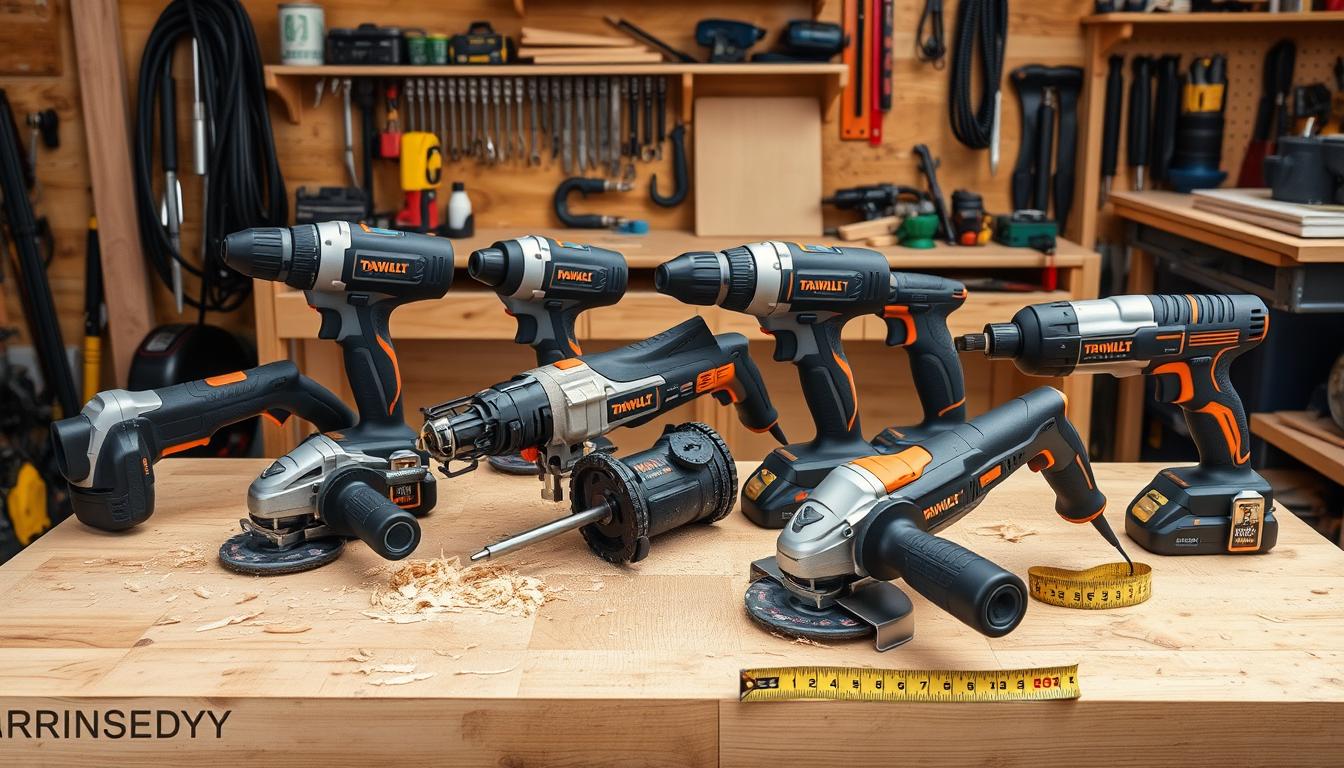Using ergonomic tools is key to avoiding injuries in workshops. These tools are made to lower injury risks and boost comfort. Knowing about power tool ergonomics helps make workshops safer and more comfortable for everyone.
Workshop injuries can be stopped by using ergonomic tools and following safety rules. Keeping workers safe is a big deal in any workshop.
Good power tool ergonomics involve the tool’s design, materials, and use. Thinking about these helps reduce injury risks and improves health. Ergonomic tools are vital for achieving this goal.
Key Takeaways
- Using ergonomic tools can help prevent workshop injuries
- Injury prevention is a top priority in any workshop
- Ergonomic tools are designed to reduce the risk of injury and improve worker comfort
- Proper safety guidelines and ergonomic tools can create a safe working environment
- Understanding power tool ergonomics is essential for workshop owners and workers
- Ergonomic tools can improve overall well-being and reduce the risk of injury
Understanding Workshop Tool Ergonomics
Workshop tool ergonomics is key to avoiding injuries and keeping workshop safety high. Using comfortable tools helps prevent fatigue and discomfort. This can lead to accidents. Studies show that ergonomic design greatly improves worker health, lowering the risk of injuries and musculoskeletal disorders.
There are important factors to think about in workshop tool ergonomics. These include:
- Tool handle design and grip considerations
- Weight distribution and balance
- Vibration control and reduction
Understanding these factors helps in designing safer, more efficient tools. This makes the work environment better, leading to more productivity and less downtime due to injuries.
The Occupational Safety and Health Administration (OSHA) emphasizes workshop safety. They say comfortable tools are crucial. By focusing on ergonomic design and workshop safety, workers can make their work environment healthier and safer.
The Hidden Costs of Poor Tool Handling
Proper tool handling is key to avoiding workplace injuries and the hidden costs they bring. Using tools poorly can cause fatigue, strains, and injuries. This leads to lost productivity, medical bills, and workers’ compensation claims. It’s vital to use the right stance and technique when handling tools to stay safe and comfortable.
Some hidden costs of poor tool handling include:
- Lost productivity due to worker absences
- Medical expenses for treating injuries
- Workers’ compensation claims
- Equipment damage and replacement costs
Workshop owners and workers can lower these risks by understanding the dangers of poor tool handling. They can do this by offering training on proper tool handling and ensuring tools are used correctly. Regular breaks also help reduce fatigue.
Studies show that using tools correctly and with the right stance can greatly lower injury risks. By focusing on worker safety and providing the right training and tools, workshop owners can prevent injuries. This also helps cut down on the hidden costs of poor tool handling.
Essential Features of Ergonomic Power Tools
Ergonomic power tools are made to cut down on fatigue and boost worker comfort. They have designs that fit well in the hand, easing strain and discomfort. Using these tools can lower injury risks and boost productivity.
Important features include handle design and grip considerations for a secure, comfy grip. Weight distribution factors affect the tool’s balance and ease of use. Also, vibration control systems lessen the vibration’s effect on hands and arms.
Examples of ergonomic tools are drills, saws, and sanders. They offer a comfy grip and cut down on vibration and strain. Workers using these tools see less injury risk and feel more comfortable and productive.
Here are some benefits of using ergonomic power tools:
- Reduced fatigue and discomfort
- Improved productivity and efficiency
- Reduced risk of injury and illness
- Improved overall worker comfort and well-being
Ergonomic power tools greatly impact worker comfort and productivity. They offer a secure grip, reduce vibration and strain, and enhance ergonomics. This helps lower injury risks and boosts worker well-being. So, using ergonomic tools is key in any workplace with regular power tool use.
| Tool Type | Ergonomic Feature | Benefit |
|---|---|---|
| Drill | Contoured handle | Reduced strain and discomfort |
| Saw | Vibration control system | Reduced vibration and fatigue |
| Sander | Soft grip handle | Improved comfort and control |
Proper Body Mechanics for Tool Use
Proper body mechanics are key to avoiding injuries in the workshop. Handling tools right means paying attention to how you stand, hold, and move. This helps prevent muscle and joint strain. It also keeps you safe and comfortable while working.
Here are some important tips for using tools safely:
- Maintain a straight back and relaxed shoulders
- Keep the tool close to your body to avoid stretching
- Use the correct grip and handle size for the tool
- Avoid repetitive motions and take breaks often
By following these tips, you can lower injury risks and stay healthy at work. Good tool handling and body mechanics are vital for a safe and productive space.
Remember, proper body mechanics are crucial for safety and tool handling. Being aware of your posture, grip, and movement helps prevent injuries. It also boosts your overall health and well-being.
| Tip | Description |
|---|---|
| Maintain a straight back | Keep your back straight and relaxed to avoid straining your muscles |
| Use the correct grip | Choose a grip and handle size that fits comfortably in your hand |
Common Workshop Injuries and Their Prevention
Workshop injuries are a big worry for everyone. Many can be stopped by using comfortable tools and keeping the right body position. Injury prevention is key to a safe work area. Knowing the risks of common injuries helps workers stay safe.
Common injuries include repetitive strain, back and shoulder problems, and hand and wrist issues. These can come from bad tool use, not enough training, and not enough breaks. To avoid these, use comfortable tools and take breaks to stretch and rest.
- Use comfortable tools that fit your hands and body
- Take regular breaks to stretch and rest
- Maintain proper body mechanics when using tools
- Get adequate training on tool use and safety
By following these tips and focusing on prevention, workers can lower their injury risk. This makes the work area safer for everyone.
| Injury Type | Cause | Prevention |
|---|---|---|
| Repetitive Strain Injuries | Poor tool handling, inadequate training | Use comfortable tools, take regular breaks |
| Back and Shoulder Problems | Heavy lifting, poor body mechanics | Maintain proper body mechanics, use lifting aids |
| Hand and Wrist Issues | Poor tool handling, inadequate rest breaks | Use comfortable tools, take regular breaks |
Organizing Your Workspace for Better Ergonomics
Having a well-organized workspace is key to keeping a proper stance and avoiding injuries. By using ergonomic tools and following simple tips, you can make your workspace better for ergonomics.
A tidy workspace can cut down on eye strain, improve your posture, and boost your productivity. Here are some tips to organize your workspace:
- Keep tools you use often within reach to avoid stretching and straining.
- Use a workbench that can adjust height for different tasks and keeps you in proper stance.
- Make sure you have good lighting and clear visibility to reduce eye strain and improve accuracy.
Optimal Tool Storage
Proper tool storage is vital for a safe and efficient workspace. Think about using a tool chest or cabinet with labeled drawers. This keeps your tools organized and easy to find.
Workbench Height Adjustments
Adjusting your workbench height helps keep you in proper stance and lowers the risk of back and neck strain. Look for a workbench with an adjustable height feature. This way, it fits different tasks and users.
Lighting and Visibility
Good lighting and clear visibility are crucial for a safe and efficient workspace. Use LED lights or natural light to brighten your area. Also, keep your workspace free from clutter and obstructions.
Selecting the Right Tools for Different Tasks
Choosing the right tools is key to tool handling and fatigue reduction. Ergonomic tools make work easier and safer. For example, a hammer with a cushioned grip helps avoid hand and wrist pain.
A tidy workshop with the right tools boosts efficiency and safety. Here are some examples:
- Drill presses for precise drilling
- Impact drivers for heavy-duty driving
- Utility knives for cutting various materials
Using the right tools can cut fatigue reduction by up to 30%. It saves workers from straining with the wrong tools. Investing in specific tools makes the workplace safer and more comfortable.
In summary, picking the right tools is vital for tool handling and fatigue reduction. Ergonomic and task-specific tools help avoid injuries and boost productivity. As a workshop owner, choosing the right tools is crucial for a safe and comfortable work environment.
| Tool | Task | Benefits |
|---|---|---|
| Drill Press | Precise Drilling | Increased accuracy, reduced fatigue |
| Impact Driver | Heavy-Duty Driving | Improved torque, reduced strain |
| Utility Knife | Cutting Various Materials | Increased versatility, reduced risk of injury |
Maintaining Your Tools for Optimal Performance
Keeping tools in good shape is key for workshop safety and injury prevention. Regular cleaning and checks can spot dangers before they cause harm. A routine maintenance plan helps avoid accidents and keeps everyone safe and healthy.
A tool in top condition is safer and works better. It makes tasks faster and safer, cutting down on injury prevention risks. Here are some ways to keep tools in good condition:
- Regularly clean and oil tools to stop rust and corrosion
- Check tools for damage or wear
- Swap out tools that are too worn or damaged
By sticking to these tips, workshops can be safer and more efficient. This leads to fewer injuries and better workshop safety and injury prevention.
It’s also important to think about these points when looking after tools:
| Tool Type | Maintenance Schedule | Inspection Checklist |
|---|---|---|
| Power Tools | Weekly | Check for damage, clean and lubricate |
| Hand Tools | Monthly | Inspect for wear and tear, clean and store properly |
By focusing on tool care and following these tips, workshops can be safer and more efficient. This reduces injury prevention risks and boosts workshop safety.
Training and Education in Tool Ergonomics
Teaching workers how to use tools safely and comfortably is key to preventing injuries. This is done through training in tool ergonomics. It focuses on using comfortable tools and ergonomic tools. Workers learn how to handle and maintain these tools, making their work safer and more comfortable.
Effective ways to train include:
- Workshops and seminars on tool safety and handling
- On-the-job training and mentoring
- Online courses and tutorials on tool ergonomics
These programs teach the value of ergonomic tools and comfortable tools in daily tasks. They lower injury risks and boost productivity.
Investing in tool ergonomics training makes workshops safer and more comfortable. It reduces injury risks and improves well-being for everyone.
Implementing Rest Breaks and Recovery Periods
Rest breaks and recovery periods are key to reducing fatigue and improving comfort at work. By taking regular breaks, workers can lower injury risks and feel better overall. Moving and standing right can also cut down on muscle strain, helping to fight fatigue.
It’s important to know when you’re getting tired. Look out for signs like less work done, more mistakes, and feeling uncomfortable. Taking breaks helps workers regain energy and focus. This leads to better work and less tiredness.
Signs of Fatigue to Watch For
- Decreased productivity
- Increased errors
- Physical discomfort
- Mental fogginess
Stretching Exercises for Tool Users
Doing simple stretches can ease muscle tension and boost comfort. Try shoulder rolls, wrist extensions, and neck stretches. Adding these to your daily routine can prevent injuries and keep you feeling good, all while keeping a good stance.
By focusing on rest breaks and recovery, workshops can become safer and more comfortable. This leads to more work done, fewer mistakes, and better health. It also helps reduce tiredness by encouraging the right posture and movement.
| Break Frequency | Break Duration | Activities |
|---|---|---|
| Every 60 minutes | 10-15 minutes | Stretching, movement, and relaxation |
| Every 2 hours | 30 minutes | Meal break, relaxation, and socialization |
Conclusion: Creating a Safer Workshop Environment
Understanding power tool ergonomics is key to a safer, more comfortable workshop. By focusing on workshop safety and tool handling, we can lower injury risks. This also boosts productivity and improves our health.
Using ergonomic power tools with good handles and balanced weight is important. Adding vibration control systems helps too. With proper body mechanics and a clean workspace, safety improves a lot.
To make a workshop safer, we need to be proactive and keep learning. Teaching workers how to use tools safely is crucial. This way, we create a safe culture for everyone.


